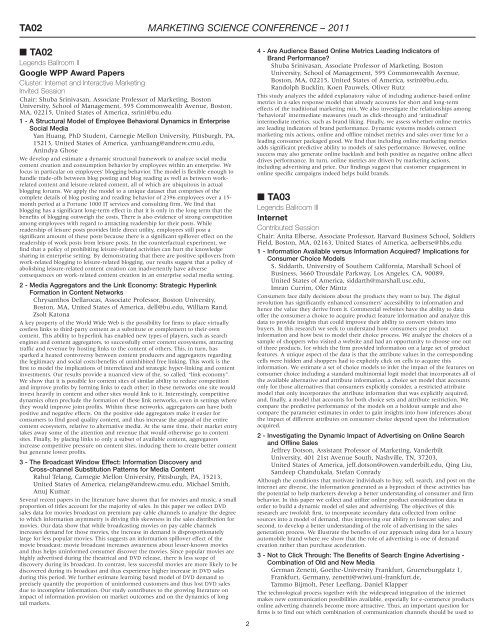Conference Sessions - Jesse H. Jones Graduate School of ...
Conference Sessions - Jesse H. Jones Graduate School of ...
Conference Sessions - Jesse H. Jones Graduate School of ...
Create successful ePaper yourself
Turn your PDF publications into a flip-book with our unique Google optimized e-Paper software.
TA02<br />
■ TA02<br />
Legends Ballroom II<br />
Google WPP Award Papers<br />
Cluster: Internet and Interactive Marketing<br />
Invited Session<br />
Chair: Shuba Srinivasan, Associate Pr<strong>of</strong>essor <strong>of</strong> Marketing, Boston<br />
University, <strong>School</strong> <strong>of</strong> Management, 595 Commonwealth Avenue, Boston,<br />
MA, 02215, United States <strong>of</strong> America, ssrini@bu.edu<br />
1 - A Structural Model <strong>of</strong> Employee Behavioral Dynamics in Enterprise<br />
Social Media<br />
Yan Huang, PhD Student, Carnegie Mellon University, Pittsburgh, PA,<br />
15213, United States <strong>of</strong> America, yanhuang@andrew.cmu.edu,<br />
Anindya Ghose<br />
We develop and estimate a dynamic structural framework to analyze social media<br />
content creation and consumption behavior by employees within an enterprise. We<br />
focus in particular on employees’ blogging behavior. The model is flexible enough to<br />
handle trade-<strong>of</strong>fs between blog posting and blog reading as well as between workrelated<br />
content and leisure-related content, all <strong>of</strong> which are ubiquitous in actual<br />
blogging forums. We apply the model to a unique dataset that comprises <strong>of</strong> the<br />
complete details <strong>of</strong> blog posting and reading behavior <strong>of</strong> 2396 employees over a 15month<br />
period at a Fortune 1000 IT services and consulting firm. We find that<br />
blogging has a significant long-term effect in that it is only in the long term that the<br />
benefits <strong>of</strong> blogging outweigh the costs. There is also evidence <strong>of</strong> strong competition<br />
among employees with regard to attracting readership for their posts. While<br />
readership <strong>of</strong> leisure posts provides little direct utility, employees still post a<br />
significant amount <strong>of</strong> these posts because there is a significant spillover effect on the<br />
readership <strong>of</strong> work posts from leisure posts. In the counterfactual experiment, we<br />
find that a policy <strong>of</strong> prohibiting leisure-related activities can hurt the knowledge<br />
sharing in enterprise setting. By demonstrating that there are positive spillovers from<br />
work-related blogging to leisure-related blogging, our results suggest that a policy <strong>of</strong><br />
abolishing leisure-related content creation can inadvertently have adverse<br />
consequences on work-related content creation in an enterprise social media setting.<br />
2 - Media Aggregators and the Link Economy: Strategic Hyperlink<br />
Formation in Content Networks<br />
Chrysanthos Dellarocas, Associate Pr<strong>of</strong>essor, Boston University,<br />
Boston, MA, United States <strong>of</strong> America, dell@bu.edu, William Rand,<br />
Zsolt Katona<br />
A key property <strong>of</strong> the World Wide Web is the possibility for firms to place virtually<br />
costless links to third-party content as a substitute or complement to their own<br />
content. This ability to hyperlink has enabled new types <strong>of</strong> players, such as search<br />
engines and content aggregators, to successfully enter content ecosystems, attracting<br />
traffic and revenue by hosting links to the content <strong>of</strong> others. This, in turn, has<br />
sparked a heated controversy between content producers and aggregators regarding<br />
the legitimacy and social costs/benefits <strong>of</strong> uninhibited free linking. This work is the<br />
first to model the implications <strong>of</strong> interrelated and strategic hyper-linking and content<br />
investments. Our results provide a nuanced view <strong>of</strong> the, so called, “link economy”.<br />
We show that it is possible for content sites <strong>of</strong> similar ability to reduce competition<br />
and improve pr<strong>of</strong>its by forming links to each other; in these networks one site would<br />
invest heavily in content and other sites would link to it. Interestingly, competitive<br />
dynamics <strong>of</strong>ten preclude the formation <strong>of</strong> these link networks, even in settings where<br />
they would improve joint pr<strong>of</strong>its. Within these networks, aggregators can have both<br />
positive and negative effects. On the positive side aggregators make it easier for<br />
consumers to find good quality content, and thus increase the appeal <strong>of</strong> the entire<br />
content ecosystem, relative to alternative media. At the same time, their market entry<br />
takes away some <strong>of</strong> the attention and revenue that would otherwise go to content<br />
sites. Finally, by placing links to only a subset <strong>of</strong> available content, aggregators<br />
increase competitive pressure on content sites, inducing them to create better content<br />
but generate lower pr<strong>of</strong>its.<br />
3 - The Broadcast Window Effect: Information Discovery and<br />
Cross-channel Substitution Patterns for Media Content<br />
Rahul Telang, Carnegie Mellon University, Pittsburgh, PA, 15213,<br />
United States <strong>of</strong> America, rtelang@andrew.cmu.edu, Michael Smith,<br />
Anuj Kumar<br />
Several recent papers in the literature have shown that for movies and music, a small<br />
proportion <strong>of</strong> titles account for the majority <strong>of</strong> sales. In this paper we collect DVD<br />
sales data for movies broadcast on premium pay cable channels to analyze the degree<br />
to which information asymmetry is driving this skewness in the sales distribution for<br />
movies. Our data show that while broadcasting movies on pay cable channels<br />
increases demand for those movies, the increase in demand is disproportionately<br />
large for less popular movies. This suggests an information spillover effect <strong>of</strong> the<br />
movie broadcast: movie broadcast increases awareness about lesser-known movies<br />
and thus helps uninformed consumer discover the movies. Since popular movies are<br />
highly advertised during the theatrical and DVD release, there is less scope <strong>of</strong><br />
discovery during its broadcast. In contrast, less successful movies are more likely to be<br />
discovered during its broadcast and thus experience higher increase in DVD sales<br />
during this period. We further estimate learning based model <strong>of</strong> DVD demand to<br />
precisely quantify the proportion <strong>of</strong> uninformed customers and thus lost DVD sales<br />
due to incomplete information. Our study contributes to the growing literature on<br />
impact <strong>of</strong> information provision on market outcomes and on the dynamics <strong>of</strong> long<br />
tail markets.<br />
MARKETING SCIENCE CONFERENCE – 2011<br />
2<br />
4 - Are Audience Based Online Metrics Leading Indicators <strong>of</strong><br />
Brand Performance?<br />
Shuba Srinivasan, Associate Pr<strong>of</strong>essor <strong>of</strong> Marketing, Boston<br />
University, <strong>School</strong> <strong>of</strong> Management, 595 Commonwealth Avenue,<br />
Boston, MA, 02215, United States <strong>of</strong> America, ssrini@bu.edu,<br />
Randolph Bucklin, Koen Pauwels, Oliver Rutz<br />
This study analyzes the added explanatory value <strong>of</strong> including audience-based online<br />
metrics in a sales response model that already accounts for short and long-term<br />
effects <strong>of</strong> the traditional marketing mix. We also investigate the relationships among<br />
‘behavioral’ intermediate measures (such as click-through) and ‘attitudinal’<br />
intermediate metrics, such as brand liking. Finally, we assess whether online metrics<br />
are leading indicators <strong>of</strong> brand performance. Dynamic systems models connect<br />
marketing mix actions, online and <strong>of</strong>fline mindset metrics and sales over time for a<br />
leading consumer packaged good. We find that including online marketing metrics<br />
adds significant predictive ability to models <strong>of</strong> sales performance. However, online<br />
success may also generate online backlash and both positive as negative online affect<br />
drives performance. In turn, online metrics are driven by marketing actions,<br />
including advertising and price. Our findings suggest that customer engagement in<br />
online specific campaigns indeed helps build brands.<br />
■ TA03<br />
Legends Ballroom III<br />
Internet<br />
Contributed Session<br />
Chair: Anita Elberse, Associate Pr<strong>of</strong>essor, Harvard Business <strong>School</strong>, Soldiers<br />
Field, Boston, MA, 02163, United States <strong>of</strong> America, aelberse@hbs.edu<br />
1 - Information Available versus Information Acquired? Implications for<br />
Consumer Choice Models<br />
S. Siddarth, University <strong>of</strong> Southern California, Marshall <strong>School</strong> <strong>of</strong><br />
Business, 3660 Trousdale Parkway, Los Angeles, CA, 90089,<br />
United States <strong>of</strong> America, siddarth@marshall.usc.edu,<br />
Imran Currim, Ofer Mintz<br />
Consumers face daily decisions about the products they want to buy. The digital<br />
revolution has significantly enhanced consumers’ accessibility to information and<br />
hence the value they derive from it. Commercial websites have the ability to data<br />
<strong>of</strong>fer the consumer a choice to acquire product feature information and analyze this<br />
data to provide insights that could improve their ability to convert visitors into<br />
buyers. In this research we seek to understand how consumers use product<br />
information and how best to model their choice process. We analyze the choices <strong>of</strong> a<br />
sample <strong>of</strong> shoppers who visited a website and had an opportunity to choose one out<br />
<strong>of</strong> three products, for which the firm provided information on a large set <strong>of</strong> product<br />
features. A unique aspect <strong>of</strong> the data is that the attribute values in the corresponding<br />
cells were hidden and shoppers had to explicitly click on cells to acquire this<br />
information. We estimate a set <strong>of</strong> choice models to infer the impact <strong>of</strong> the features on<br />
consumer choice including a standard multinomial logit model that incorporates all <strong>of</strong><br />
the available alternative and attribute information, a choice set model that accounts<br />
only for those alternatives that consumers explicitly consider, a restricted attribute<br />
model that only incorporates the attribute information that was explicitly acquired,<br />
and, finally, a model that accounts for both choice sets and attribute restriction. We<br />
compare the predictive performance <strong>of</strong> the models on a holdout sample and also<br />
compare the parameter estimates in order to gain insights into how inferences about<br />
the impact <strong>of</strong> different attributes on consumer choice depend upon the information<br />
acquired.<br />
2 - Investigating the Dynamic Impact <strong>of</strong> Advertising on Online Search<br />
and Offline Sales<br />
Jeffrey Dotson, Assistant Pr<strong>of</strong>essor <strong>of</strong> Marketing, Vanderbilt<br />
University, 401 21st Avenue South, Nashville, TN, 37203,<br />
United States <strong>of</strong> America, jeff.dotson@owen.vanderbilt.edu, Qing Liu,<br />
Sandeep Chandukala, Stefan Conrady<br />
Although the conditions that motivate individuals to buy, sell, search, and post on the<br />
internet are diverse, the information generated as a byproduct <strong>of</strong> these activities has<br />
the potential to help marketers develop a better understanding <strong>of</strong> consumer and firm<br />
behavior. In this paper we collect and utilize online product consideration data in<br />
order to build a dynamic model <strong>of</strong> sales and advertising. The objectives <strong>of</strong> this<br />
research are tw<strong>of</strong>old: first, to incorporate secondary data collected from online<br />
sources into a model <strong>of</strong> demand, thus improving our ability to forecast sales; and<br />
second, to develop a better understanding <strong>of</strong> the role <strong>of</strong> advertising in the sales<br />
generation process. We illustrate the benefits <strong>of</strong> our approach using data for a luxury<br />
automobile brand where we show that the role <strong>of</strong> advertising is one <strong>of</strong> demand<br />
creation rather than purchase acceleration.<br />
3 - Not to Click Through: The Benefits <strong>of</strong> Search Engine Advertising -<br />
Combination <strong>of</strong> Old and New Media<br />
German Zenetti, Goethe-University Frankfurt, Grueneburgplatz 1,<br />
Frankfurt, Germany, zenetti@wiwi.uni-frankfurt.de,<br />
Tammo Bijmolt, Peter Leeflang, Daniel Klapper<br />
The technological process together with the widespread integration <strong>of</strong> the internet<br />
makes new communication possibilities available, especially for e-commerce products<br />
online adverting channels become more attractive. Thus, an important question for<br />
firms is to find out which combination <strong>of</strong> communication channels should be used to

















